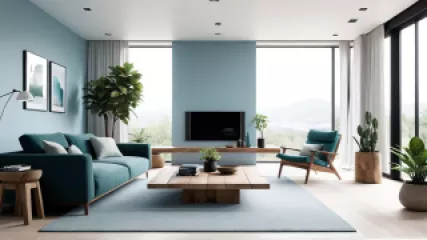Designing Calming Spaces: The Psychology of Space
Designing Calming Spaces: The Psychology of Space
In today's fast-paced, technology-driven world, the importance of creating peaceful, restorative environments has never been more critical. Our physical surroundings have a profound impact on our mental and emotional well-being, influencing our mood, productivity, and overall quality of life. This ultimate guide delves into the psychology of space, examining how strategic design choices can cultivate calming, wellness-focused interiors that support both our physical and mental health.
Understanding the Psychology of Space
The field of environmental psychology has long studied the dynamic relationship between individuals and their physical environments. Researchers have discovered that the way we experience and interact with our surroundings can have a significant effect on our cognition, emotions, and behavior. From the color palette to the layout and lighting, every element of a space can trigger specific psychological responses.
At the core of this concept is the idea that our environments can either energize or deplete us, depending on how they are designed. Calming spaces that promote relaxation, focus, and mindfulness are crucial for maintaining mental wellness and overall well-being. By understanding the psychology of space, we can intentionally create interiors that support our mental and emotional needs.
The Importance of Wellness-Focused Design
In recent years, the concept of wellness-focused design has gained widespread attention, as more people recognize the profound impact our surroundings can have on our health and happiness. This holistic approach to interior design goes beyond mere aesthetics, prioritizing the creation of environments that nurture both the mind and body.
Wellness-focused design is particularly relevant in the wake of the COVID-19 pandemic, which has highlighted the importance of creating spaces that support mental health and emotional resilience. As many individuals continue to spend more time at home, the need for calming, restorative environments has become increasingly urgent.
Whether it's a private residence, a workplace, or a healthcare facility, the principles of wellness-focused design can be applied to a wide range of settings. By incorporating elements that promote relaxation, mindfulness, and overall well-being, we can create spaces that empower individuals to thrive both physically and mentally.
The Psychology of Color in Interior Design
One of the most powerful tools in the designer's arsenal is the strategic use of color. Color has a profound impact on our emotions, cognition, and physiological responses, making it a crucial consideration in the creation of calming spaces.
Research has shown that certain colors can elicit specific psychological reactions. For example, cool tones like blues and greens are often associated with feelings of tranquility and relaxation, while warmer hues like reds and oranges can be more stimulating and energizing.
In the context of wellness-focused design, the strategic use of color can help to create a soothing, restorative atmosphere. By incorporating calming color palettes, designers can minimize visual stimulation and promote a sense of serenity. Conversely, the thoughtful application of more vibrant hues can be used to energize and inspire, depending on the specific needs of the space and its occupants.
The Importance of Lighting in Calming Spaces
Lighting is another crucial element in the design of calming, wellness-focused spaces. The quality, intensity, and distribution of light can have a significant impact on our mood, productivity, and overall well-being.
Research has shown that exposure to natural light can have a positive effect on our circadian rhythms, regulating sleep patterns and boosting mood. In contrast, harsh, artificial lighting can contribute to eye strain, headaches, and feelings of stress and fatigue.
When designing calming spaces, it's essential to prioritize the use of soft, indirect lighting that mimics the natural fluctuations of daylight. This can be achieved through the strategic placement of lamps, the incorporation of dimmers, and the use of natural materials that diffuse and reflect light in a soothing manner.
The Role of Texture and Materiality
In addition to color and lighting, the textures and materials used in a space can also have a significant impact on its overall atmosphere and psychological effects. Tactile qualities like softness, warmth, and natural materials can contribute to a sense of comfort and relaxation, while harsher, more industrial finishes may feel more stimulating or even overwhelming.
When designing calming spaces, it's important to consider the sensory experience of the environment. Incorporating natural, organic materials like wood, stone, and fabric can help to create a sense of grounding and connection with the natural world. Soft furnishings, plush textiles, and natural fibers can also contribute to a cozy, comforting ambiance.
By carefully curating the textures and materials within a space, designers can cultivate a multisensory experience that promotes relaxation, mindfulness, and overall well-being.
The Importance of Biophilic Design
Biophilic design is a concept that has gained increasing attention in the realm of wellness-focused interior design. Rooted in the idea that humans have an innate need to connect with nature, biophilic design aims to incorporate natural elements, patterns, and processes into the built environment.
Research has shown that exposure to natural elements, such as plants, natural light, and views of the outdoors, can have a profoundly positive impact on our mental and physical health. Biophilic design harnesses these benefits, creating spaces that foster a sense of calm, focus, and overall well-being.
By incorporating biophilic elements into the design of calming spaces, designers can help to alleviate stress, boost mood, and promote a deeper connection between individuals and their surroundings. This can be achieved through the strategic placement of potted plants, the integration of natural materials, and the incorporation of natural lighting and views.
Designing for Mindfulness and Meditation
In recent years, the practice of mindfulness and meditation has gained widespread popularity as a means of reducing stress, improving focus, and enhancing overall well-being. As such, the design of spaces that support these practices has become an increasingly important consideration in the realm of wellness-focused interior design.
When designing calming spaces for mindfulness and meditation, it's essential to create an environment that is free from distractions and promotes a sense of serenity. This can be achieved through the use of soft, indirect lighting, neutral color palettes, and the incorporation of natural elements that help to create a soothing, grounding atmosphere.
Additionally, the layout and furnishings of the space should be designed to facilitate comfortable, uninterrupted practice. This may include the strategic placement of meditation cushions, the incorporation of built-in storage for meditation props, and the creation of designated areas for individual or group practice.
The Role of Technology in Calming Spaces
In the digital age, the integration of technology into our living and working spaces is an unavoidable reality. However, the strategic use of technology can also play a role in the creation of calming, wellness-focused environments.
For example, the incorporation of smart home technologies that allow for the seamless control of lighting, temperature, and other environmental factors can help to create a sense of comfort and relaxation. Additionally, the use of virtual therapy platforms and other digital wellness tools can provide individuals with access to mental health support and resources within the comfort of their own homes.
At the same time, it's essential to strike a balance between the integration of technology and the creation of spaces that promote mindfulness and disconnection. By thoughtfully curating the use of digital devices and media, designers can help to minimize visual and auditory stimulation, creating an environment that encourages focus, relaxation, and overall well-being.
Designing for Specific Needs and Populations
While the principles of calming, wellness-focused design can be applied universally, it's important to recognize that different individuals and populations may have unique needs and preferences when it comes to their physical environments.
For example, individuals with mental health conditions, such as anxiety or depression, may benefit from spaces that incorporate specific design elements that reduce sensory overload and promote a sense of safety and control. Similarly, healthcare settings and other specialized environments may require a tailored approach to ensure that the design effectively supports the well-being of the occupants.
By understanding the unique needs and preferences of different populations, designers can create calming spaces that are truly responsive to the individuals who will be using them. This may involve the incorporation of specialized features, the consideration of specific accessibility requirements, and the use of evidence-based design strategies that have been proven to support the mental and physical health of the intended users.
Conclusion: Embracing the Power of Calming Spaces
As we continue to navigate the challenges of the modern world, the importance of creating calming, wellness-focused spaces has never been more critical. By understanding the psychology of space and the principles of wellness-focused design, we can cultivate environments that support our mental and emotional well-being, empowering us to live, work, and thrive in a more harmonious and restorative way.
Whether it's a private residence, a workplace, or a healthcare facility, the strategic design of calming spaces can have a profound impact on our overall quality of life. By prioritizing elements like color, lighting, texture, and biophilic design, we can create environments that promote relaxation, mindfulness, and a deeper connection to the natural world.
As we move forward, the continued evolution and integration of wellness-focused design principles will be crucial in shaping the spaces we inhabit. By embracing the power of calming, restorative environments, we can unlock the full potential of our physical surroundings to support our mental, emotional, and physical well-being, ultimately leading to a more holistic and fulfilling way of living.






